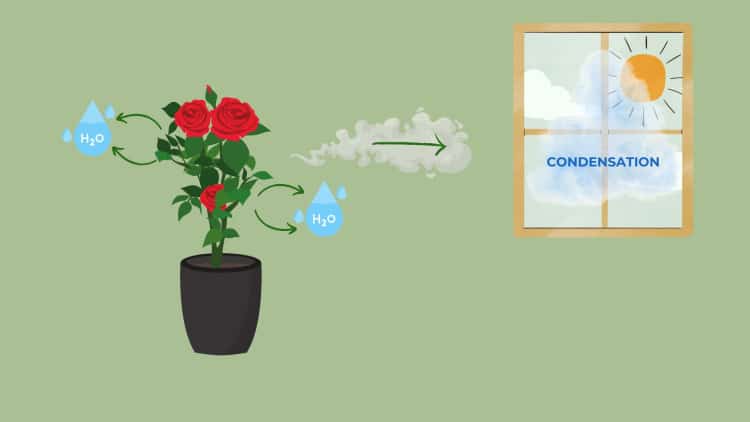Particularly as the weather cools outside, condensation can build up on your windows and surfaces indoors. Find out some of the best indoor houseplants to grow to reduce the amount of condensation in your home.
Find out my advice for the best houseplants to reduce condensation in my YouTube video:
Do plants help with condensation?
The answer to whether plants help with condensation, is yes and no. There are some plants that are more likely to contribute, and others that can help. Knowing which is which will help you to best tackle condensation in your home.
What is transpiration?
This is basically the plant equivalent to human sweat. Plants, like us, can release small amounts of water from their cells to help them cool down when they’re hot. This is done by opening ‘stomata’ in their leaves, to release small amounts of water vapour into the air through evaporation.
Therefore, when plants do this, they increase the likelihood of seeing condensation in warmer rooms of your home. The increase in water vapour in the air will lead to more condensation on your cool windows.

Do houseplants absorb water in the air?
Yes, many houseplants come from tropical and subtropical environments, so thrive in high-humidity areas. These are plants which are well-adapted to absorbing water vapour and moisture from the air around them.
In fact, some plants need to stay in rooms with higher humidity to survive, so are perfect for keeping in rooms like your bathroom or your kitchen.
Plus, houseplants which love high humidity environments can help to reduce the amount of moisture in the air. As a result, they can reduce the amount of condensation in a room.

What are ‘xerophytes’?
Xerophytes are plants which have evolved to retain as much moisture as possible. This is because they have grown and evolved in more arid environments, like deserts and dry plains. They can’t rely on consistent rainfall or moisture from the ground, so limit how much water lost through transpiration as possible.
The benefit of having these plants in your home is not only are they easy to grow, but they will not contribute to condensation build-up. Their ability to retain moisture means they won’t add any to the air, reducing any chances of increasing condensation levels.

Best plants to reduce condensation
1. Peace Lily (Spathiphyllum)
- These attractive houseplants absorbs humidity from the air through their leaves and require little sunlight.
- Their attractive ‘flowers’ aren’t actually flowers at all; they are modified leaves called bracts.
- The name ‘Spathyphyllum’ literally describes the white bracts of this plant; phyll meaning ‘leaf’, and spath being ‘spathe’, to describe the leaf-shaped ‘flower’.

2. Boston Fern or Sword Fern (Nephrolepsis exaltata)
- Boston Ferns are types of epiphytes, which are plants that grow on other plant surfaces.
- This means they absorb moisture and nutrients from the air, rather than relying solely on taking it from the roots.

3. Snake Plant (Sansevieria trifasciata) (or Dracaena trifasciata)
- These plants absorb moisture and survive particularly well in humid environments.
- Snake plants also happen to be extremely low maintenance, perfect for even the most novice houseplant growers.
- In addition to this, they also work hard at night to remove carbon dioxide and produce precious oxygen.

4. English Ivy (Hedera helix)
- These plants thrive in environments with at least 40% humidity, absorbing it from the air.
- The two abilities combined can also make it a great benefit in combatting mould indoors too.

5. Palms
- Palms are typically found in damp; tropical regions of the world so absorb humidity through their leaves.
- Examples include Lady’s palm (Rhapis excelsa), Bamboo palm (Chamaedorea seifrizii), or Areca palm (Dypsis lutescens).

6. Orchids
- Like ferns, these are epiphytes – acquire nutrients and moisture from the air around them.
- Their aerial roots will often grow out of the soil in search of moisture in the air, sunlight, and other nutrients.
- You should try to grow orchids like Moth orchids (Phalaenopsis) in clear containers, as their roots contain chlorophyll, helping them to photosynthesise.

7. Spider plant (Chlorophytum)
- Spider plants absorb humidity from the air and prefers low-light rooms and shady spots.
- They also improve indoor air quality. Easy to care for and adapt well to different conditions.
- Also known as the ‘hens and chickens’ plant as it spreads by little plantelets appearing on long stalks.

8. Cacti
- These plants rarely need watering. They take in water from the surrounding air instead of requiring water in the roots.
- They have the capacity to store large amounts of water in their stems, which is how they survive such arid conditions.
- This is also why they have spines (which are actually highly evolved leaves), to protect their valuable water contents from other creatures, including humanity.

9. Succulents
- Like cacti, succulents are xerophytes, meaning they have very low levels of transpiration.
- They take in the air they need for photosynthesis at night by opening their stomata. Therefore, this oxygen it can be used during the daytime, when they have more access to sunlight.
- By opening the stomata only at night, these plants significantly reduce the amount of water they lose by transpiration.

Choose the right plants for your home, to help you reduce condensation levels inside.

Leave A Comment